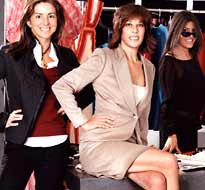
Photo: Gavin Bond
If you’re not looking too carefully, dressing for work in 2002 looks like a free-for-all. People wear jeans with delicately worn holes in the thighs, and sneakers with platform soles and garish logos. Others wear custom-made suits, perfectly pressed, cuff links gleaming. But whatever the level of formality—from all-Armani to shorts and flip-flops—there are rules specific to each office culture. The mandates are more complex than they once were—the days of the yellow tie are long gone, and power suspenders are barely hanging on. But displays of status endure, and the codes of what to wear when are as well known to employees as anything distributed by the HR department. To chart New York’s rapidly changing professional culture, we visited seven New York offices in seven different industries, and did field work on their dress codes. Just about everyone we spoke to was highly conscious of his (or her) wardrobe choices—and, not surprisingly, acutely aware of what the boss chooses to wear, too. In some industries—at the art gallery, for example—nothing is valued above creativity; curating a collection of vintage dresses displays an aspiring assistant’s taste. In a tabloid newsroom, executives favor shirts with cuffs—but the jacket is never seen, except when the owner makes an appearance. The power publicist is always impeccably suited in Bill Blass—and she would never leave her house in a pair of flats. And some things never change: The young lawyer announces his arrival at a big corporate firm with the watch—Cartier—that he can suddenly afford. Clothes don’t make the man, or the woman. But they sure can help make a career.
NEXT: Seven Offices. Seven Looks.
What to Wear at the Office
Architects •••
Advertising Agency ••• Newsroom ••• Record Label •••
Designer Publicists ••• Corporate Lawyers ••• Art Gallery